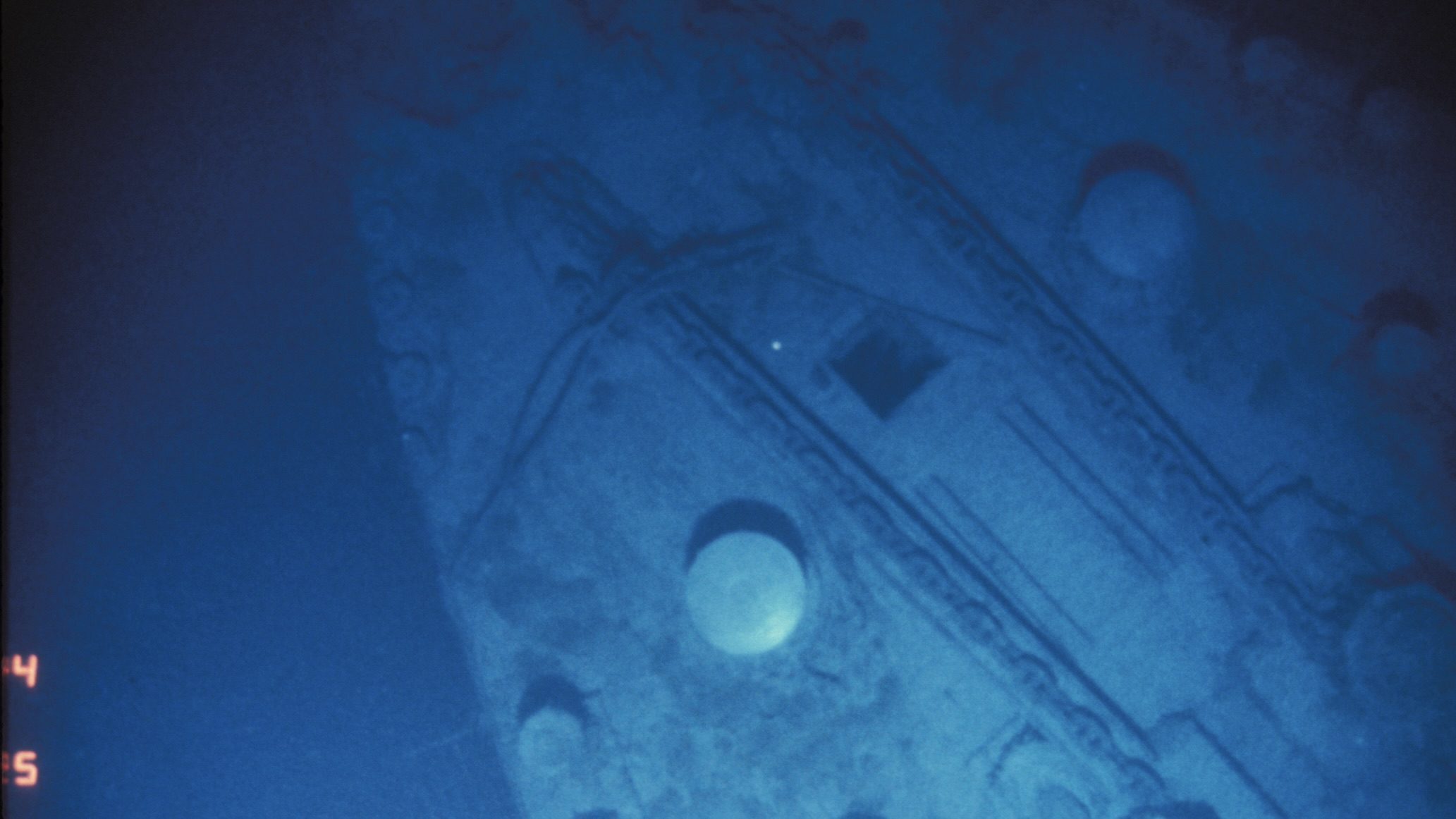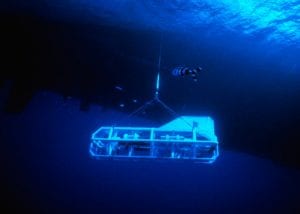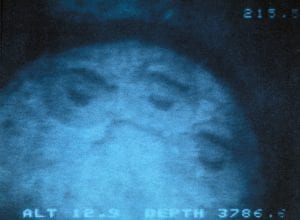Forty years after the Titanic discovery, Woods Hole Oceanographic Institution continues to advance ocean research and exploration

How cutting-edge technology, novel search techniques, and persistence paid off
Rarely seen images, video, and audio of the discovery can be found here.
Woods Hole, Mass. (August 8, 2025) – On September 1, 1985, the wreck of the RMS Titanic was discovered about 12,500 feet (3,800 meters) beneath the surface of the North Atlantic by an international team led by Woods Hole Oceanographic Institution (WHOI) and the French oceanographic institution, IFREMER. The expedition, led by Robert Ballard–then head of WHOI’s Deep Submergence Lab–used innovative technology and search techniques that helped spawn a new era in deep-sea exploration and discovery.
Deep ocean technology has evolved over the past 40 years, but the discovery remains one of the world’s most famous oceanographic achievements and set the stage for decades of scientific breakthroughs that followed.
At the time of the expedition, WHOI was already a world leader in oceanographic research and deep-sea exploration. The human occupied vehicle (HOV) Alvin launched in 1964, was one of the first research submersibles capable of carrying humans to extreme ocean depths. In 1977, a team led by WHOI scientists Dr. Richard Von Herzen and Dr. Ballard helped discover hydrothermal vents, which changed the understanding of life on Earth by proving that ecosystems could exist without sunlight. This growing expertise in deep-water survey and exploration turned out to be extremely helpful to the U.S. Navy and pivotal to the eventual discovery of RMS Titanic.
In the summer of 1985, Ballard and his crew quietly set out for the North Atlantic on the Navy-owned research vessel Knorr, with new WHOI-developed underwater imaging technology to survey the wreckage of the USS Scorpion, a nuclear submarine lost at sea in 1968.

The Argo towed camera sled had television cameras and sonars that helped find Titanic. It was named by Titanic expedition leader Robert Ballard after the mythical Greek vessel that carried Jason on his quest for the Golden Fleece. In 1985, Argo represented a new generation of exploration vehicles for ocean scientists. (Woods Hole Oceanographic Institution)
Onboard was ARGO, a unique remotely operated deep-sea vehicle equipped with a video camera system and side-scan sonar for mapping the seafloor in detail. Unlike earlier systems, ARGO transmitted real-time video to the control room aboard Knorr, enabling researchers to identify seafloor anomalies immediately instead of waiting for film to be developed. This real-time imaging approach marked a turning point in ocean exploration.
They also carried one of the first uncrewed camera systems called ANGUS which was lowered on a non-conducting trawl wire that would be used to photograph the Titanic once it was found.
The plan was for the French to use their new side-scanning sonar called SAR that conducted a series of overlapping swaths called “mowing the lawn” to ensure they covered 100% of the ocean floor. But after covering 50% of the total search area, they failed to find it. Ballard was now faced with what seemed like an impossible challenge since the Navy wanted him to image the wreck of the USS Scorpion before heading to the Titanic search area.
Since the Titanic had broken apart well before reaching the bottom (as had the Scorpion), he decided not to look for the Titanic but to search for its trail of debris, which in the case of the Scorpion, was over one mile long. This way, he could spread his search lines one mile apart and quickly cover the remaining search effort.

The first evidence that researchers aboard the R/V Knorr had found the RMS Titanic came on September 1, 1985, from the distinct rivet pattern of one of its boilers. (Photo by: ©Woods Hole Oceanographic Institution)
In the early morning hours of September 1, after less than one week of scouring the seafloor for the trail of debris, his fatigued team recognized one of Titanic’s boilers, and then they followed the debris to the north, leading them to the wreck of the Titanic itself. After 73 years lying at the bottom of the North Atlantic, the RMS Titanic had been found.
“Finding the Titanic was extraordinarily exciting, but simultaneously a bit gut-wrenching,” explained Stewart Harris, chief engineer on WHOI’s Argo project. “Over 1500 people lost their lives in the accident, and with all the hoopla surrounding the discovery, it was important for us to be mindful of that. Nonetheless, the technology demonstration was an eye-opener for the oceanographic community.”
According to a 1985 New York Times report, “The Titanic's discovery awaited the creation of sophisticated new robots to explore the inky depths of the ocean bottom, in particular, the ARGO, an advanced robot craft equipped with searchlights and television and still cameras that can survive the crushing pressure of the ocean's weight and pierce the darkness miles under water.”
The team’s success using ARGO to find the Titanic and ANGUS to film it proved that uncrewed, towed imaging systems could be used for deep-sea exploration. In 1986, Ballard and a team from WHOI returned to the Titanic’s resting place with HOV Alvin and Jason Jr., a miniature remotely operated vehicle mounted to and controlled from the submersible, to conduct a detailed exploration of the wreckage. Alvin and Jason Jr. captured some of the first up-close images of the ship, inside and out, revealing details about the ship’s deterioration and providing scientific insights into deep-sea corrosion and microbial activity on shipwrecks.
According to Dana Yoerger, senior scientist at WHOI, who was part of the Titanic discovery team, “Ballard taught us all that searching in the ocean requires planning, the right mix of technologies, patience, and discipline. Today, we program our autonomous robots following his example.”
Since the Titanic's discovery in 1985, deep-ocean exploration technology has advanced significantly. Today, autonomous underwater vehicles (AUVs) and remotely operated vehicles (ROVs) enable more advanced research, deeper dives, and more efficient mapping. Ultra-high-definition cameras, including those developed by WHOI’s MISO Facility, provide high-resolution imagery of deep-sea environments. Multi-beam, high-resolution sonar and 3D mapping, including deep-sea photogrammetry, relay sharply defined details. More powerful control systems and new search strategies have helped AUVs deliver a wealth of discoveries about the deep, perpetually dark seafloor.
“Titanic proved to be a pivotal moment in exploration of the deep sea. The addition of larger area search and survey technology, coupled to Alvin, was among the first effective demonstrations of robots and humans working together in the deep ocean,” said Andy Bowen, principal engineer at WHOI, who designed Jason Jr. for the 1986 return to Titanic. ”Our development of the ROV Jason Jr. and subsequent, larger Jason vehicle created an inflection point that accelerated our access into the deep sea. The resulting technology and its impact have added a surprising and welcome dimension to Titanic’s legacy.
“The success in the discovery of the Titanic, and the subsequent ocean exploration technologies developed since, have provided an incredible foundation for a new generation of ocean explorers,” said WHOI’s Anna Michel, Chief Scientist of the NSF-funded National Deep Submergence Facility (NDSF), which operates Alvin and Jason. “Today’s early career engineers and researchers can look back with pride at the history created by the teams that helped in the discovery of the Titanic.”
The discovery of the Titanic in 1985 was made possible by the novel use of real-time imaging, debris field analysis, and towed deep-sea vehicles—strategies that remain fundamental in modern exploration. Today, WHOI continues to lead in the development of cutting-edge oceanographic technologies, helping unlock the secrets of one of the planet’s final frontiers.
In Ballard’s words “The discovery of the Titanic opened a new chapter in deep sea exploration, since the deep sea is the largest museum in the world with an estimated 3 million chapters of human history in its depths, most of which are waiting to be discovered by the next generation of underwater explorers”.
Bonus footage of the 1985 discovery is available here.
###
About Woods Hole Oceanographic Institution
Woods Hole Oceanographic Institution (WHOI) is a private, non-profit organization on Cape Cod, Massachusetts, dedicated to marine research, engineering, and higher education. Established in 1930, its mission is to understand the ocean and its interactions with the Earth as a whole, and to communicate an understanding of the ocean’s role in the changing global environment. WHOI’s pioneering discoveries stem from an ideal combination of science and engineering—one that has made it one of the most trusted and technically advanced leaders in fundamental and applied ocean research and exploration anywhere. WHOI is known for its multidisciplinary approach, superior ship operations, and unparalleled deep-sea robotics capabilities. We play a leading role in ocean observation and operate the most extensive suite of ocean data-gathering platforms in the world. Top scientists, engineers, and students collaborate on more than 800 concurrent projects worldwide—both above and below the waves—pushing the boundaries of knowledge to inform people and policies for a healthier planet. Learn more at whoi.edu.
